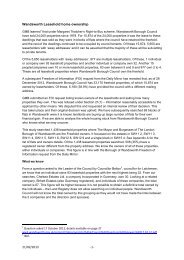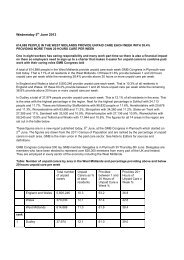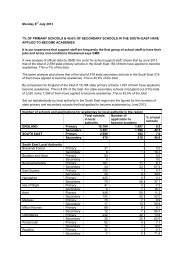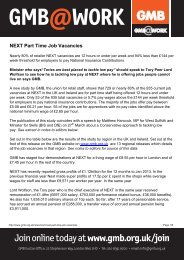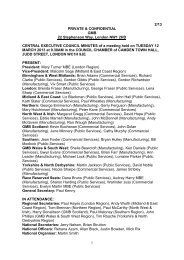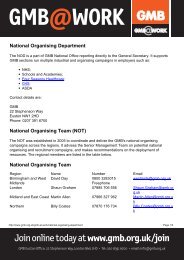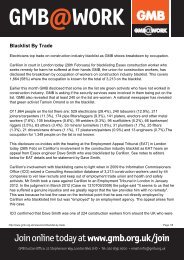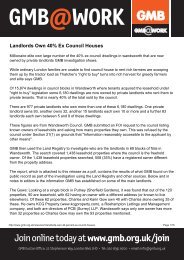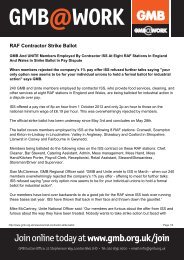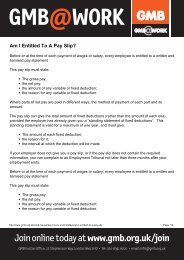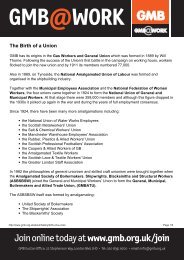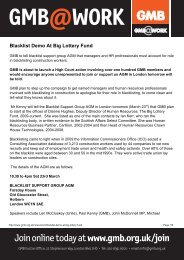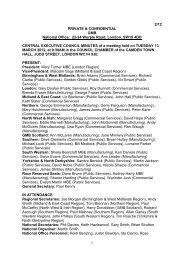WO toolkit 2012 complete.pdf - GMB
WO toolkit 2012 complete.pdf - GMB
WO toolkit 2012 complete.pdf - GMB
Create successful ePaper yourself
Turn your PDF publications into a flip-book with our unique Google optimized e-Paper software.
SECTION 17.2<br />
Deaf and deaf<br />
“deaf’written in lower case denotes the medical condition of hearing loss.Upper case‘Deaf’is the<br />
political and social term of belonging to the Deaf community.It is used in the same way other<br />
nationalities and groups would be spelt with upper case letters,e.g.Spanish or Muslim.”(Deaf and<br />
Creative,University of Wolverhampton).<br />
Disability–Legal Position<br />
The Disability Discrimination Act 1995 defines disability as‘a physical or mental impairment,which has<br />
a substantial and long term adverse effect on a person’s ability to carry out normal day to day<br />
activities’.This may affect a person’s mobility,manual dexterity,physical co-ordination; continence;<br />
ability to lift or move everyday objects; speech,hearing; eyesight; memory or ability to understand,<br />
concentrate or learn; perception of the risk of danger.<br />
Disability–Medical Model<br />
From a medical model perspective,people are disabled by their impairment and the absence or<br />
reduction of functionality that it causes.There is a focus on medical intervention–disability is<br />
something the person is burdened with,which should be cured so they may become as‘normal’as<br />
possible.<br />
Disability–Social Model<br />
From a social model perspective,people are disabled,not by their impairment,but by the<br />
environmental,social&attitudinal barriers that prevent them from participating fully as members of<br />
society.There is a focus on the removal of barriers,and providing‘different but equal’treatment to<br />
enable all people to participate.<br />
Disabled person(people)<br />
A disabled person is someone who has an impairment,experiences externally exposed barriers and<br />
self-identifies as a disabled person.<br />
Discrimination<br />
The law recognises two main types of discrimination,direct&indirect.<br />
Discrimination–Direct<br />
Occurs when one person is treated less favourably than another would be in the same or not materially<br />
different circumstances,on the basis of their gender,gender identity,race,sexual orientation,religion<br />
or belief,disability or age.<br />
Discrimination–Indirect-informal<br />
Occurs where a law,regulation,policy or practice,which is apparently neutral,would put persons of a<br />
given group(e.g.on grounds of gender,race,ethnic or national origins,sexual orientation,religion or<br />
belief-or none)at a particular disadvantage compared with another person,unless the provision,<br />
criterion or practice can be objectively justified by a legitimate aim and the means of achieving that<br />
aim are appropriate and necessary(i.e.proportionate).A key difference between direct and indirect<br />
discrimination is that indirect discrimination can occur through informal practices as well as formal<br />
ones.It can happen unwittingly through practices,provisions or criteria that have a disproportionate<br />
negative impact on a particular group.



